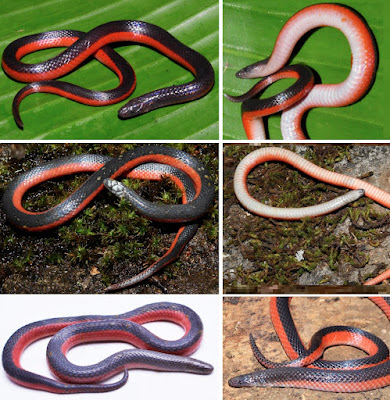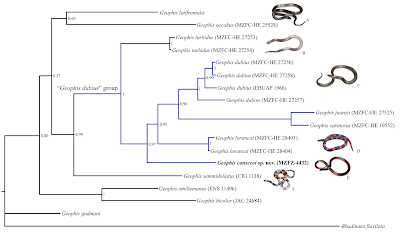Abstract
A new species of the Geophis dubius group is described from the cloud forests in the mountains north of Xalapa, Veracruz. This new species is most similar to G. turbidus and G. lorancai, from which it differs genetically as well as by a very unique color pattern, morphological characters, and habitat use. The validity of G. fuscus, which was described from central Veracruz, is discussed. With the description of the new species and our assessment of G. fuscus, the number of species in the Geophis dubius group increases to 14 and the number of species of Geophis to 52.
Keywords. Geophis dubius group, Geophis fuscus, Geophis lorancai, Geophis turbidus, montane cloud forest, new species, Sierra de Misantla, Sierra Madre Oriental
 |
| Holotype ofGeophis cansecoi sp. nov. MZFZ 4432 from Los Capulínes, Municipio de Yecuatla, Veracruz, Mexico. (A) Dorsolateral perspective in life. (B) Lateral perspective in life. |
 |
| Paratypes of Geophis cansecoi sp. nov. in life. (A–B) MZFZ 4435; (C–D) INIRENA 2812; (E) INIRENA 2814; (F) MZFZ 4434; all from the vicinity of Los Capulínes, Municipio de Yecuatla, Veracruz, Mexico. |
Geophis cansecoi sp. nov.
Diagnosis. A member of the Geophis dubius group, as
defned by Downs (1967) and expanded by Wilson and
Townsend (2007), and characterized by the following
combination of traits: eye relatively small; single
supraocular and postocular present on each side (with
one exception, see below); no anterior temporal scale,
penultimate supralabial and parietal in contact; second
infralabials small, broadly separated from each other;
mental scale and anterior chinshields in contact; smooth
dorsal scales throughout the body arranged in 17 rows;
ventrals 134–142 in females (n = 7), and 125–131 in
males (n = 7); subcaudals 28–35 in females (n = 7), and
34–37 in males (n = 7), with ventral + subcaudal totals
163–173 in females (n = 7) and 159–165 in males (n = 7);
tail length 11.6–16.3% of TotL in females, 16.7–19.0%
of TotL in males; dorsal pattern slate gray, with crimson
red lateral stripe on each side, usually on frst three or
four scale rows but occasionally occupying part of the
ffth; venter pale cream, except on the ventral surfaces of
the head and throat, which are gray; maxillary teeth 6–8.
...
Distribution, habitat, and ecology. This species appears
to be restricted to the immediate vicinity of the type
locality in the Sierra de Misantla portion of the Sierra
Madre Oriental of Veracruz, Mexico (Fig. 10). It has been
collected between 1,550–1,763 m asl in mesic cloud forest.
Specimens were found beneath a variety of decomposing
logs, trash, and rocks, and also crossing the road at night.
All specimens were collected in the month of June.
Etymology. The specific epithet honors to Luis Canseco-Márquez, a Mexican herpetologist who has dedicated a
portion of his career to the study of snakes of the genus
Geophis.
Christoph I. Grünwald, Iván T. Ahumada-Carrillo, André J. Grünwald, Carlos E. Montaño-Ruvalcaba and Uri O. García-Vázquez. 2021. A New Species of Geophis (Dipsadidae) from Veracruz, Mexico, with Comments on the Validity of Related Taxa. Amphibian & Reptile Conservation. 15(2); Taxonomy Section: 289–310. (e294).
Resumen.—Se describe una nueva especie del grupo de Geophis dubius del bosque mesóflo de montaña al
norte de Xalapa, Veracruz. Esta nueva especie es mas parecido a G. turbidus y G. lorancai, de cuales se diferencía
geneticamente y por su coloración única, carácteres morfológicas y preferencia de hábitat particular. También
disuctimos la valídez de G. fuscus, cual también fue descrito del centro de Veracruz. Con la descripción de la
nuev especies, y nuestro análisis de G. fuscus, el numero de especies del grupo Geophis dubius se aumenta
a 14 y el número de especies de Geophis a 52.
Palabras clave. Bosque mesóflo de montaña, Geophis fuscus, Geophis lorancai, grupo de Geophis dubius, nueva
especie, Sierra de Misantla, Sierra Madre Oriental



